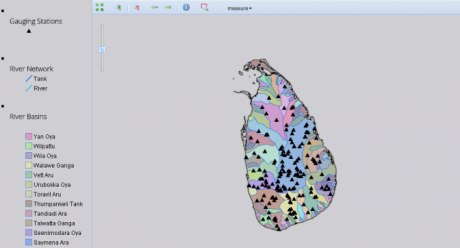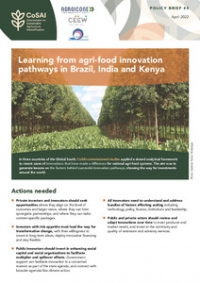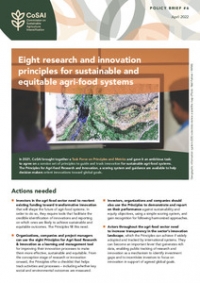An online information system to aid government, researchers and development agencies in managing water resources and ecosystems in Sri Lanka has attracted more than 2,300 users since being launched a year ago.
The Sri Lanka Water Resources Information System provides maps and data on water availability, quality and use, and is an archive of more than 700 water-related scientific papers that can be downloaded.
An important tool on the site is an environmental flow calculator for Sri Lanka, which can tell a user how much river water flow is needed to maintain and bolster the health of ecosystems. The Mahaweli Authority, whose mission includes rehabilitating and maintaining Sri Lanka’s irrigation network, used the tool for river basin planning and water master plan preparation.
The website also includes information on dozens of water basins, stream runoff data and maps that show agricultural areas with high vulnerability to droughts, floods, sea level rise and landslides.
The online portal was developed by scientists at the International Water Management Institute (IWMI), with support from the CGIAR Research Program on Water, Land and Ecosystems. Former President Mahinda Rajapakse formally launched the information portal last year when visiting IWMI’s headquarters in Colombo, Sri Lanka.
Herath Manthrithilake, head of IWMI’s Sri Lanka Development Initiative, said current users include government department officials, researchers and academics, consultants, students, NGOs and the private sector.
“Our eventual goal is to hand it over to a (government) agency to run after we populate it with as much data as we can,” Manthrithilake said.

“Our eventual goal is to hand it over to a (government) agency to run after we populate it with as much data as we can.”
Data show that 60 percent of the users are 18 to 34 years old, nearly half are women (46 percent), and nearly half are from outside the country, such as from the United States, Australia and the United Kingdom. Reflecting the growing popularity of mobile devices, 40 percent of the users have accessed the site from iPads and iPhones.
The system has four levels of access, ranging from public data, downloadable data by registered users, and more sensitive data such as project data accessible only to authorized users. A feature of the tool is that it enables registered users to upload their own data while keeping ownership over it, and to comment on existing data.
A one-day training was conducted last year with participants from about 15 different government agencies in the country. Additional data sets were added to the site in December, and Manthrithlake said he is in discussions with Sri Lanka’s Ministry of Environment to add water quality data. Currently, there is data on the quality of water in Jaffna, a northern province affected by the country’s civil war that ended in 2009.
Ian Makin, the new leader of IWMI’s revitalized irrigation systems theme, said he used the Sri Lanka information portal as an example in discussions with agencies in Mongolia and Bhutan to move in similar directions. While Sri Lanka’s system serves as an archive of data, the Asian Development Bank is promoting systems to provide live access to current data, Makin said. As in Sri Lanka, there would be different levels of access for the public, partners and internal government use.
IWMI tried to promote a similar water information system a decade ago when working on the first edition of the World Water report with UNESCO. While that initial effort didn’t lead to a Sri Lankan water information system, it did lead to the IWMI global Water Data portal that exists in an expanded form today. The Sri Lankan Information System is part of IWMI’s efforts to make water data more open and accessible to users. It is linked to the IWMI Water Data Portal, which houses all IWMI data and is open access.












